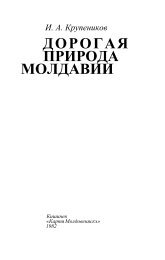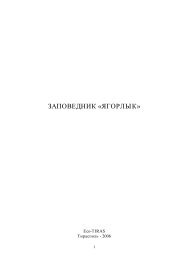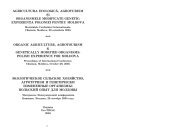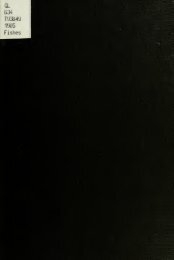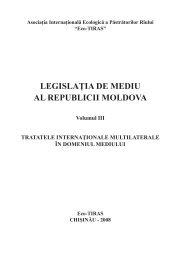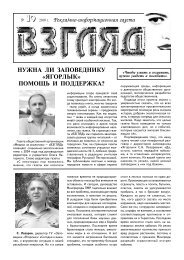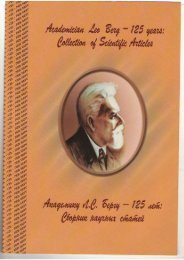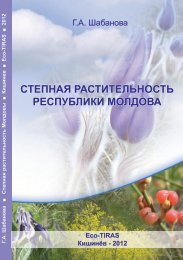и конкуренты нативных видов, например двустворчатыемоллюски: Dreissena bugensis (Andrusov, 1897)появление которой отмечено в бассейне Днестра(Тодераш и др., 2006; Филиппенко, Лейдерман, 2006);а также – Sinanodonta woodiana (Lea, 1834) (Мунжиу,Шубернецкий, 2008); Corbicula fluminea (Müller, 1774)(Мунжиу, Шубернецкий, 2010), которые, не смотря нанедавнее появление, уже сформировали устойчивыепопуляции в бассейне р. Прут и вероятно их появлениев бассейне Днестра – это вопрос времени. Успехинвазии обеспечивают особенности, способствующиеуспешному расселению, во-первых – личинка, затем– быстрое достижение репродуктивного возраста, отсутствиеили небольшое количество врагов, высокаяпродуктивность.Согласно правилу «десяти» (tens rule – теории,оценивающей успех инвазии) на каждую из стадийинвазионного процесса переходит 10 % видов; так10 % из занесенных видов задерживаются (повторновстречаются) в местах заноса, из них 10 % могут обосноватьсяв месте заноса, и лишь 10 % последних распространяютсядалее и могут стать «агрессорами»(Williamson, Brown, 1986).Водоемы Республики Молдовы относятся кПалеарктической области и к Понто-Каспийской солоноватойобласти, эстуарные районы которой даютбольшое количество иммигрантов близкородственныхи экологически сходных видов. Поэтому необходиморазличать инвазию ближних и дальних вселенцев.Криптические виды – морфологически сходныес каким-либо местным видом и часто не отмеченыпри исследованиях, например Ferrissia fragilis (Tryon,1863) и криптогенные виды, происхождение которыхне определено.Необходимо отметить появление в реке Днестр(Паланка, 2010) чужеродного североамериканскоговида Gastropoda с колпачковидной раковиной– Ferrissia fragilis (Tryon, 1863), криптического т.е. морфологическисходного с автохтонным видом Acroloxuslacustris и малозаметного (размер раковины 3-5 мм),что затрудняло его обнаружение и идентификацию.На данный период исследований Ferrissia fragilis непредставляет угрозу для данной экосистемы, однакоего численность составляет 200 экз./м 2 , в то же времяу Acroloxus lacustris -120 экз./м 2 , следовательно,существует вероятность вытеснения местного вида инегативного влияния на сохранение генофонда автохтонноймалакофауны. В связи с этим и возможностьюинвазий других чужеродных видов, необходимо проводитьмониторинг данного участка Днестра, для выявленияи разработки мер по предотвращению негативноговлияния инвазий на экосистему реки Днестр.Исследования в области биологических инвазийпозволили выявить наличие крупных инвазионных коридоров– путей распространения большого количествавидов – вселенцев. Строительство каналов связавшихрусла Дуная, Днепра, Днестра, Дона, Рейна, Волгипривело к созданию крупных инвазивных коридоров.Водные экосистемы низовий Днестра, Прута и малыхрек бассейна Дуная на территории Республики Молдоваотносятся к так называемому «Южному Инвазивномукоридору». В этих экосистемах риск инвазий самый высокий.Водоемы Северного Причерноморья это один изключевых регионов в процессах формирования биоинвазиймирового масштаба.Строительство в Республике Молдова Морскогопорта Джурджулешть (2006 г) повышает риск инвазийчужеродных видов гидробионтов в местные водоемыи его эксплуатация должна предусматривать разработкуи выполнение мер по предотвращению возможныхинвазий.ВыводыСледовательно, учитывая вышеизложенное, необходимопроведение исследований по выявлениючужеродных видов в водных экосистемах Молдовы,определению способов проникновения, факторовобусловивших изменение границ ареала чужеродныхвидов, технологии аквакультуры, успеху натурализации,степени экспансии. Необходимо исследоватьвлияние чужеродных видов эдфикаторов на функционированиеводной экосистемы Днестра (формированиепервичной продукции, биоразнообразие фито,зоопланктона и бентоса, влияние на микробиологическиепоказатели, вклад в биогенную миграцию веществаи энергии). Необходима разработка и выполнениерегиональной программы направленной на решениепроблем связанных с биологическим загрязнением.Список литературы1. Алимов А. Ф., Богуцкая Н.Г. Биологические инвазии в водныхи наземных экосистемах. КМК. Москва-Санкт-Петербург. 2004.436 с.2. Владимиров М.З. Восточная речная креветка Macrobrachiumnipponense (de Haan) – новый элемент гидрофауны Кучурганскоговодохранилища// Известия АН МССР Серия биол. и хим. наук. 1989,№1. Кишинев. С.77-78.3. Владимиров М.З. Новые сведения о пресноводном малощетинковомчерве Branchiura sowerbyi Европейской части СССР//Известия АН МССР. Серия биол. и хим. наук. 1989, №2. Кишинев.С.73-74.4. Владимиров М.З. Состояние популяций интродуцированныхв водоемы Молдавии некоторых видов высших ракообразных лиманно-каспийскойфауны // Комплексное использование водоемовМолдавии. Кишинев, 1981. С.157-161.5. Владимиров М.З., Кубрак И.Ф. О нахождении нового дляихтиофауны бассейна Днестра вида бычков (Caspiosoma caspium)//Вопросы ихтиологии. Т.12. Вып. 2 (73). Москва, 1972. С.386-387.6. Зеленин А.М., Владимиров М.З. Новые данные о распространениии биологии бычка Knipowitschia longicaudata (Kessler)Известия АН МССР. Серия биол. и хим. наук. 1975, №5. Кишинев.С.44-46.7. Зеленин А.М., Владимиров М.З. О нецеленаправленномрасширении ареала амурского чебачка (Pseudorasbora parva)// Актуальныевопросы зоогеографии. VI Всес. Зоогеографическая конференция.Тезисы докладов. Кишинев. 1975. С.93.8. Зеленин А.М., Набережный А.И. К вопросу выращиваниябелого амура и толстолобика в прудах Молдавии.//Биологическиересурсы водоёмов Молдавии. Кишинев: Штиинца, 1962, с.68-75.9. Зубкова Е.И., Зубкова Н.Н., Турятко И.П., ШубернецкийИ.В., Пернай В.И. Дальневосточная кефаль пелингас Mugul soiuyBasilewsky – новый перспективный вид прудового рыбоводства //Вопросы рыбного хозяйства Беларуси. Сб. науч.трудов. вып.24.–Минск РУП «Институт рыбного хозяйства», 2008. – С.89-90.10. Карлов В.И, Крепис О.И. Перестройка ихтиофауны, распределениеи структура популяций промыслово-ценных видов//Биопродукционные процессы в водохранилищях охладителях ТЭС.165-180. Кишинев Штиинца. 1988.11. Лобченко В.В. Интродукция, акклиматизация и проблемабиоразнообразия Днестра.// Сохранение биоразнообразия бассейнаДнестра. Материалы Международной конференции. Кишинев.Октябрь 7-8. 1999. С.<strong>13</strong>0-<strong>13</strong>1.12. Романеску В. К. К вопросу о критериях об определениибычков (Gobiidae) бассейна реки Днестр.// Академику Л.С. Бергу– <strong>13</strong>0 лет. Сборник научных статей. Бендеры. 2006. С.112-166.<strong>13</strong>. Филипенко С.И., Лейдерман А.И. Динамика развития популяциидрейссены в Кучурганском водохранилище-охладителе МолдавскойГРЭС // Академику Л.С. Бергу – <strong>13</strong>0 лет: Сборник научныхстатей. – Бендеры: <strong>Eco</strong>-TIRAS, 2006. – С. 116-118.— 147 —
14. Ярошенко M.Ф., Дедю И.И, Кубрак ИФ, Зеленин АМ. Итогии перспективы акклиматизации рыб и кормовых беспозвоночных вводоемах Молдавии.// Совещание по итогам и перспективам акклиматизациирыб и беспозвоночных в водоемах СССР. Тезисы. 1965.С. 24-26.15. Ярошенко M.Ф. Гидрофауна реки Днестр. АН СССР. Москва.1957.168 с.16. Coada V., Popa V. Diversitatea malacologică fluviului Nistru оnporţiunea or. Otaci-or.Vadul-lui-Vodă. Академику Л.С. Бергу – <strong>13</strong>0 лет.Сборник научных статей. Бендеры. 2006. P.66-68.17. Kiseliova O. Population ecology and reproductive peculiaritiesof fish species with short life spans from the lower sector of the DniesterRiver. PhD thesis, Chisinau: 2009. 95 pp.18. Munjiu O, Shubernetsky I. First record of Sinanodonta woodiana(Lea, 1834) (Bivalvia: Unionidae) in Moldova.//Aquatic Invasions.Volume 3, Issue 4, 2008. P.441-44219. Munjiu O, Shubernetsky I. First record of Asian clam Corbiculafluminea (Mьller, 1774) in the Republic of Moldova.// Aquatic Invasions.Volume 5, Supplement 1, 2010, P.67-70.20. Son M.O. Invasive mollusks in fresh and brackish waters ofNorthern Black sea Region. Odessa. 2007a. <strong>13</strong>2p.21. Son M.O. North American fresh water limpet Ferrissia fragilis(Tryon, 1863) (Gastropoda: Planorbidae) – a cryptic invader in theNorthern Black Sea Region. Aquatic Invasions V.2 2007b. Р.55-58.22. Toderaş I.Ch., Reva V.A., Chiroşca V.V. Polimorfismul moluştelorgenului Dreissena (Mollusca, Bivalvia), din bazinul hidrografic al fluviuluiNistru.//Buletinul Acad. de Şt. a Moldovei. N1(298). Chişinău. 2006.P.<strong>13</strong>4-<strong>13</strong>8.23. Toderash I., Vladimirov M. Aspectul structural-cantitativ aicomunităţilor zoobentonice a ecosistemelor acvatice din bazinulhidrografic al râului Prut.// Академику Л.С. Бергу – <strong>13</strong>0 лет. Сборникнаучных статей. Бендеры. 2006.P.<strong>13</strong>4-<strong>13</strong>7.Evolution of shrew (Mammalia, Soricomorpha, Soricidae) communitiesin Republic of Moldova in the last decadesV. Nistreanu, A. Savin, A. Larion, N. Corcimaru, V. Burlacu*, N. CaramanInstitute of Zoology, Academy of Sciences of Moldova, vicnistreanu@gmail.com* – National Scientific-Practical Centre of Preventive MedicineThe shrews are the smallest mammals of the worldfauna and represent a wide spread group of animals inthe ecosystems of Moldova. At the same time they areof great importance in natural environment and in humaneconomy, being important link within the animal trophicchain. Six shrew species inhabit in Moldova: commonshrew (Sorex araneus), pygmy shrew (S. minutus),bicolored shrew (Crocidura leucodon), lesser shrew (C.suaveolens) and Mediterranean water shrew (Neomysanomalus).In the XXth century in our republic this group was ratherpoor studied by comparing with other mammals. Dataconcerning the shrews can be found in the monograph“Animal world of Moldova” in “Mammals” volume (Lozan,1979) and in some other papers, where shrew speciesare mentioned (Averin et al., 1984; Munteanu & Savin,1990). The most serious work concerning the insectivorespecies in Moldova was published by Lozan (1975), wherecan be found data on morphology, ecology, palaeontologyand spreading of shrews on the territory of Moldova.After 2000 this group of mammals is intensely studied.Some data on shrew biology can be found in “Animalworld of Moldova” in “Mammals” volume (Munteanu &Lozan, 2004), as well as in several papers where shrewspecies are mentioned as components of small mammalcommunities in various types of ecosystems (Munteanu,2005; Tikhonov et al., 2009 a, b; Tikhonova et al., 2009).In the last several years shrew species were studiesmore detailed from morphological, zoogeographical andecological point of view (Nistreanu, 2007, 2008; Nistreanuet al, 2008, 2009 a, b). The paper contains some dataconcerning the evolution of shrew communities in the lastseveral decades on the territory of Moldova.Materials and methodsThe paper is based on the material collected in thepast century by the researchers of Laboratory of Mammal<strong>Eco</strong>logy, which is kept in the laboratory collection, as wellas on the existing published and non-published data.The information of the last 5 years regarding the shrewspecies is based on the studies of the authors on thewhole territory of Moldova.Shrews were caught with snap traps and fall trapsin various types of ecosystems in the northern, centraland southern parts of the republic. The animals weremeasured, weight, the sex, age and reproductivestatus were determined, the skull were preserved forfurther morphological studies. The following indexeswere considered: trappability, relative abundance,frequency.Results and discussionsIn the last years some considerable modification ofshrew communities in various types of ecosystems on thewhole territory of Moldova were registered by comparingwith the situation from the past century.In the 1970’s the dominant species among shrewsin natural ecosystems was S. araneus, followed by N.anomalus. The species S. minutus and C. suaveolenswere rather spread on the republic territory, but had lowabundance, while C. leucodon was registered only infew natural ecosystems with very low abundance (fig.1). The proportion of common shrew among other shrewspecies was the highest in forest ecosystems (insularforests in the northern part, central forest, forest shelterbelts), in meadows of Nistru and Prut rivers, in wet biotpesnear woods. In insular woods from the northern part thecommon shrew constituted about 5-16% from all thesmall mammals, in wet oak forests with well developedshrub and herbaceous vegetation its abundancereached 20%, while in lower Prut marshes this speciesconstituted up to 55% from all the small mammals(Lozan, 1975, 1979). In the southern part of the republicin steppe zone this species was very rare. In agriculturalecosystems, such as old orchards, forest shelter beltsthe density of the common shrew was rather low (3-4individuals per 100 traps). The trappability index of thespecies was between 3% and 12% depending on thebiotope (Lozan, 1975). The Mediterranean water shrewwas also rather spread, but mostly in wet biotopes, nearvarious water sources. It abundance in such biotopesreached about 30% from all the shrews. Together withthe common shrew it constituted about 80% from theshrew population of the republic (fig. 1). The white-— 148 —
- Page 3 and 4:
Descrierea CIP a Camerei Nationale
- Page 5 and 6:
Уважаемые коллеги,
- Page 7 and 8:
щегосударственной
- Page 9 and 10:
доме, в котором мы в
- Page 11 and 12:
шие глубины на заде
- Page 13 and 14:
с малыми восстанов
- Page 15 and 16:
Литература1. Жадин
- Page 17 and 18:
Рис. 3. Многолетняя
- Page 19 and 20:
тера и глубины изме
- Page 21 and 22:
ПОДДЕРЖАНИЕ БИОРАЗ
- Page 23 and 24:
Таблица 5. Оптималь
- Page 25 and 26:
Таблица. Результат
- Page 27 and 28:
ФОРМИРОВАНИЕ БИОЦЕ
- Page 29 and 30:
Подавляющее больши
- Page 31 and 32:
Рис.1. Днестр вблизи
- Page 33 and 34:
сопоставимости дан
- Page 35 and 36:
ции с международны
- Page 37 and 38:
А.Н. Бургеля, К.П. Бу
- Page 39 and 40:
Выводы1. Уже на само
- Page 41 and 42:
тегории, виды и пор
- Page 43 and 44:
санитарно-эпидемио
- Page 45 and 46:
Таблица 4. Распреде
- Page 47 and 48:
реационных, монито
- Page 49 and 50:
Шабановой Г.А. и Кух
- Page 51 and 52:
могут быть убраны,
- Page 53 and 54:
Турунчук. Связь с с
- Page 55 and 56:
Праздник «День Рек
- Page 57 and 58:
500ЈPРис. Распределе
- Page 59 and 60:
Н. Гроссу * , Р. Шакир
- Page 61 and 62:
Рис.1. Помесячное ра
- Page 63 and 64:
Calitatea apei r. Nistru conform gr
- Page 65 and 66:
Карта геохимическо
- Page 67 and 68:
лесу был дуб, сегод
- Page 69 and 70:
При предварительно
- Page 71 and 72:
щих улучшить социа
- Page 73 and 74:
ней опасных загряз
- Page 75 and 76:
ФотоприложениеФот
- Page 77 and 78:
в Украине - одесска
- Page 79 and 80:
тия по гидрохимиче
- Page 81 and 82:
ветствующих санита
- Page 83 and 84:
ния полей, так и для
- Page 85 and 86:
В. Экономический ан
- Page 87 and 88:
Таким образом, плат
- Page 89 and 90:
Рис. 2. Динамика нор
- Page 91 and 92:
Табл. 1а. Статистиче
- Page 93 and 94:
Выводы1. Наибольшее
- Page 95 and 96:
Для днестровской в
- Page 97 and 98: ЭКОЭТИЧЕСКОЕ ВОСПИ
- Page 99 and 100: Таблица 1. Валовое с
- Page 101 and 102: почвенный покров п
- Page 103 and 104: always been the public concern of b
- Page 105 and 106: и уникальными по си
- Page 107 and 108: ются основными фак
- Page 109 and 110: Рис. 4. Пораженность
- Page 111 and 112: ight to use”. Varone et al. (2002
- Page 113 and 114: mass media, etc., which belong to d
- Page 115 and 116: В связи с тем, что К
- Page 117 and 118: период поездки вых
- Page 119 and 120: doutchinae (d’Orb.), выше з
- Page 121 and 122: вместе с осадками в
- Page 123 and 124: Таблица 4. Содержан
- Page 125 and 126: efectuat în baza următorilor indi
- Page 127 and 128: видуальных различи
- Page 129 and 130: - соответствующее з
- Page 131 and 132: ФАУНА КЛЕЩЕЙ ДРЕВЕ
- Page 133 and 134: Таблица 1. Данные ра
- Page 135 and 136: РЕКРЕАЦИОННЫЕ РЕСУ
- Page 137 and 138: ЭТАПЫ ЭВОЛЮЦИИ БИО
- Page 139 and 140: Плотина Дубоссарск
- Page 141 and 142: чимые. При этом «пе
- Page 143 and 144: Схематически получ
- Page 145 and 146: Таблица 5. Данные на
- Page 147: Risks for biodiversity with tested
- Page 151 and 152: 20082009Fig. 2. Structure of shrew
- Page 153 and 154: с природой (различн
- Page 155 and 156: делить в их предела
- Page 157 and 158: Таблица. Оценка эне
- Page 159 and 160: лах Приднестровья
- Page 161 and 162: ВыводыКраеведческ
- Page 163 and 164: вий среды жизнедея
- Page 165 and 166: Senecio besserianus Minder. Cypripe
- Page 167 and 168: Рис.1. Почвенная кар
- Page 169 and 170: половины площади п
- Page 171 and 172: Рис. 2. Современное
- Page 173 and 174: ПРИЧИНЫ ГЕОМОРФОЛО
- Page 175 and 176: RÂURILE MICI CU ŞANSE MARIDE A FI
- Page 177 and 178: ЭКОНОМИКО-ЭКОЛОГИЧ
- Page 179 and 180: прибрежной зоной (п
- Page 181 and 182: Строительство в пр
- Page 183 and 184: государственного у
- Page 185 and 186: ческий, социальный
- Page 187 and 188: ми, послужило весом
- Page 189 and 190: губительно влияющи
- Page 191 and 192: ных за контролем и
- Page 193 and 194: PECULARITIES OF DYNAMICS OF PHOSPHO
- Page 195 and 196: Fig. 4. Spatial and seasonal dynami
- Page 197 and 198: • inventory of point discharges s
- Page 199 and 200:
СТЕРИЛИЗАЦИЯ КАК С
- Page 201 and 202:
гормоны (в незначит
- Page 203 and 204:
ПРОТОКОЛ ПО ПРОБЛЕ
- Page 205 and 206:
воды ежегодно умир
- Page 207 and 208:
РАЗРАБОТКА ПЛАНОВ
- Page 209 and 210:
ставляет материаль
- Page 211 and 212:
• Совершенствован
- Page 213 and 214:
«Алые паруса». Таки
- Page 215 and 216:
which the Committee is then require
- Page 217 and 218:
нием, культурой и х
- Page 219 and 220:
- Николаевская церк
- Page 221 and 222:
Сброшенный на 50 м б
- Page 223 and 224:
СТРУКТУРА ГЕОИНФОР
- Page 225 and 226:
4. Пространственная
- Page 227 and 228:
На фазе пика числен
- Page 229 and 230:
А.А. Тищенков, В.В. М
- Page 231 and 232:
Распределение видо
- Page 233 and 234:
цветковый (ККП, ЧКУ,
- Page 235 and 236:
очередной задачей
- Page 237 and 238:
схемой планировани
- Page 239 and 240:
эксплуатационным п
- Page 241 and 242:
ных дамб, с возвращ
- Page 243 and 244:
ледствия от урбани
- Page 245 and 246:
ОСНОВНЫЕ ФОРМЫ ДЕГ
- Page 247 and 248:
УЧАСТИЕ НЕПРАВИТЕЛ
- Page 249 and 250:
струкции как от сбр
- Page 251 and 252:
Рогоз широколистны
- Page 253 and 254:
Таблица 3. Изменени
- Page 255 and 256:
В рамках первых тре
- Page 257 and 258:
Основные экскурсио
- Page 259 and 260:
2. Кравченко Е.Н. При
- Page 261 and 262:
Decision-Maker user group are respo
- Page 263 and 264:
может ее запускать,
- Page 265 and 266:
поражения населени
- Page 267 and 268:
тию РДЮЦ «ГУТТА - кл
- Page 269 and 270:
мость разработки н
- Page 271 and 272:
Биология. Подорожн
- Page 273 and 274:
банизированных тер
- Page 275 and 276:
Результаты исследо
- Page 277 and 278:
площадь ассимиляци
- Page 279 and 280:
Рис. 3. Дендрограмма
- Page 281 and 282:
Рис.1. Сезонная дина
- Page 283 and 284:
Молдовы и Приднест
- Page 285 and 286:
Ребята приехали в 10
- Page 287 and 288:
Рис. 1. Численность
- Page 289 and 290:
жений, в том числе э
- Page 291 and 292:
[4]. Несомненно, выжи
- Page 293 and 294:
КОНСТИТУЦИОНАЛЬНА
- Page 295 and 296:
В настоящее время б
- Page 297 and 298:
8. Суворцева В.Ю., Ру
- Page 299 and 300:
Окончание табл. 2Ок
- Page 301 and 302:
содержаниеПРЕДИСЛ
- Page 303 and 304:
А.П. Погребняк, В.Ф.
- Page 305:
Научное изданиеБАС


![[download]13,2 Mb - Eco - Tiras](https://img.yumpu.com/50284532/149/500x640/download132-mb-eco-tiras.jpg)
